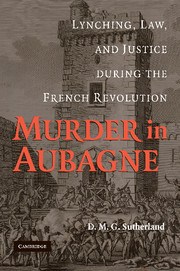Book contents
- Frontmatter
- Contents
- List of Figures
- Preface
- Acknowledgments
- Abbreviations
- Aubagne: An Introduction to the Problem
- 1 Structures and Events
- 2 The Olive Festival
- 3 Aubagne's Universe: Marseille, Aix, and Arles, 1789–1792
- 4 Murders in Provence
- 5 Vigilantism and Federalism
- 6 Federalism
- 7 Terror in a Small Town: Aubagne
- 8 The Revolution of the Antiterrorists: Vengeance, Massacre, and Justice
- 9 The Bande d'Aubagne
- Conclusion
- Appendix
- Sources and Methods
- Index
2 - The Olive Festival
Published online by Cambridge University Press: 13 August 2009
- Frontmatter
- Contents
- List of Figures
- Preface
- Acknowledgments
- Abbreviations
- Aubagne: An Introduction to the Problem
- 1 Structures and Events
- 2 The Olive Festival
- 3 Aubagne's Universe: Marseille, Aix, and Arles, 1789–1792
- 4 Murders in Provence
- 5 Vigilantism and Federalism
- 6 Federalism
- 7 Terror in a Small Town: Aubagne
- 8 The Revolution of the Antiterrorists: Vengeance, Massacre, and Justice
- 9 The Bande d'Aubagne
- Conclusion
- Appendix
- Sources and Methods
- Index
Summary
The story begins in the late winter of 1791–2 with a festival. This was the fête des olliviers, the Olive Festival, a traditional Provençal and Mediterranean folkloric gathering that celebrated the flowering of the olive trees and more generally the coming of spring after the usual short winter. It is a remarkable fact that almost all those who attended the fête des olliviers in Aubagne that year were associated with the murderers three years later, while those who tried to prevent it, the municipality, the Jacobin club, and others, were prominent among the victims. Indeed, the most spectacular victim of the Year III (1795) was Jean-Baptiste Domergue, the mayor of Aubagne three years before. He went to great lengths to disperse the fête. Conversely, one of the victims of the hangings in September 1792, eight months after the fête, was attacked in part because he had attended the fête.
Of course, a festival commemorating the flowering of olive trees is an unremarkable event in normal times. What made this one a revealing moment in local social and political relations was the context. For the context revealed the extent of the splits and the depth of the factionalization in the town well before the lynchings and well before the murders began.
The Olive Festival took place on Sunday, 12 February 1792. Attendance was by invitation only. The festivities were to take place on the outskirts of town, at the château of Belloi, the summer residence of the bishop of Marseille.
- Type
- Chapter
- Information
- Murder in AubagneLynching, Law, and Justice during the French Revolution, pp. 35 - 63Publisher: Cambridge University PressPrint publication year: 2009

